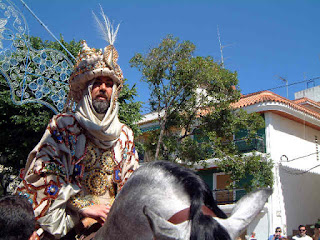
Boll Nuevo is a small seaside town near Mazarron, after which the tarmac road is replaced by a dirt road that continues along the coast. Bol Nuevo itself has a fine sandy beach and a campsite right on the beach. The pitches are, however, small and contain an obstacle course of trees.

The track follows round some picturesque bays, see photo, where the red rocks look particularly striking. With so many little inlets and coves along this coastline, it offers good cover for illegal immigration. The local press often reports the police or customs picking up their usually much overloaded boats, which must have travelled over 100 miles from the North African coast. There are, however, quite a number of North Africans, mainly Moroccans, legitimately working in Spain, in the tomato greenhouses, for example.
Other furtive characters can more frequently be spotted in these little bays: the nudists. They are allowed to use a designated strip of coast (get it – “strip” !!) along from Bol Nuevo, and are all males, sometimes to be seen striking a pose in a high visibility position. The walking group tends not to stop for lunch breaks at these locations as it puts you off your sausage sandwiches.

















